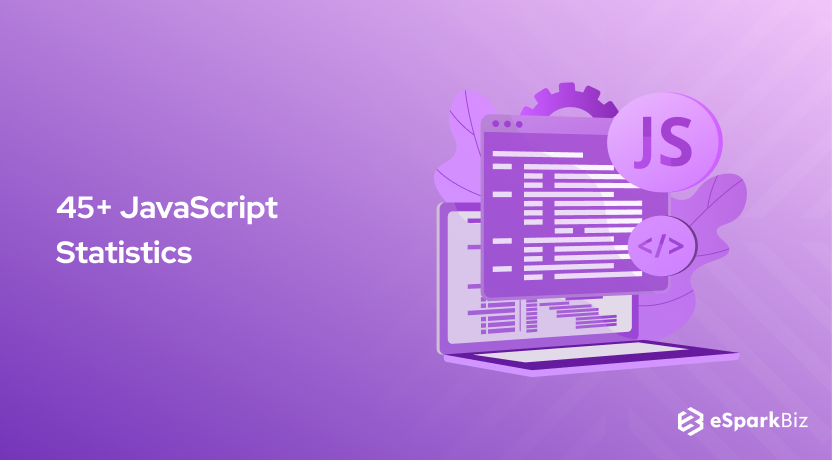In the competitive digital era, every business strives to stay ahead and make a significant impact on consumers. Therefore, they focus on the look and feel of their websites.
Have you ever wondered about the secret behind the attractiveness and interactivity of websites? Well, that is where front-end development comes into the picture.
The backend takes care of the functionality and coding of the apps. On the other hand, front-end development is responsible for ensuring that all the components of the user interface are designed to deliver a seamless customer experience.
The frontend development offers you a deeper understanding of how users interact with your web applications and websites. That is why its significance cannot be overlooked.
Knowing about the frontend statistics can provide you with better insights into popular technologies, evolving trends, and how they are shaping the future of web development. Read on to explore everything in detail!
A Quick Glance of Front-End Development
Front-end development refers to the process of building a user interface where the users interact. The core aim is to develop the visual and interactive aspects of the web applications or websites using a variety of design tools, frameworks, and programming languages. With front-end development, making a positive impact and delivering an exceptional experience becomes easy.
Top Frontend Statistics to know for choosing your ideal framework
Popularity of Front-End Frameworks
When it comes to front-end frameworks statistics, the first thing you must know about is the popularity of different frameworks. No doubt, React and Angular are among the top frameworks leveraged by developers.
However, frameworks like Vue and Svelte also have exciting functionalities and features, making them useful for web development. Delve into the key front-end frameworks statistics relating to the popularity.
- Nearly 83 percent of JavaScript development makes use of React as the primary front-end framework.
- On the other hand, 77 percent of developers leverage Vue.js while 43 percent rely on Angular.
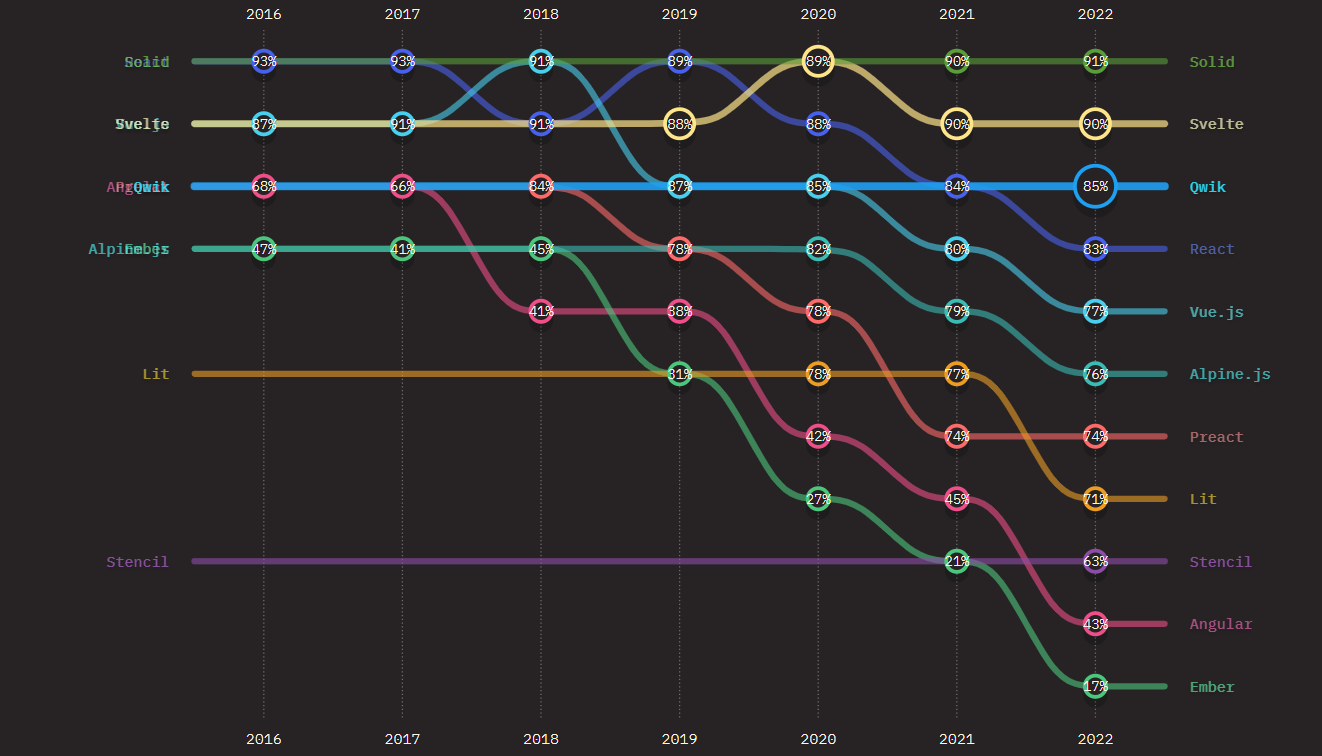
- As per StackOverflow 2023 report, the popularity of ReactJS stands at 40.58 percent.
- 19.89 percent of developers choose Angular for building fast and reliable web applications.
- Vue.JS is the best front-end development framework among 17.64 percent of professional developers.
- According to the survey of StackOverflow, React is the most popular framework.
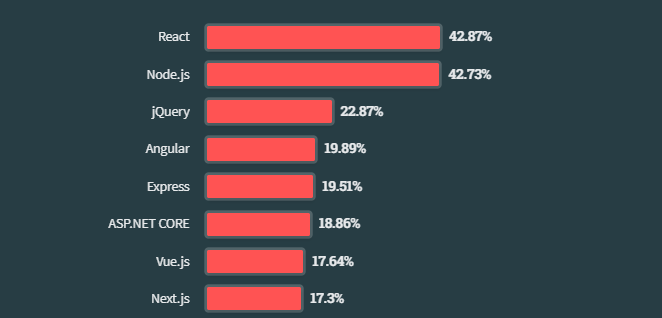
- 42.87 percent of professional developers prefer using the React framework for front-end development.
Also Read : Top 20 JavaScript Framework Of All Times
Front-End Developers in the U.S.
The next front-end frameworks statistics you must know relate to the developers. Delve into the key statistics!
- There are more than 218,350 front-end developers in the United States.
- The average age of the front-end developers is nearly 36 years.
- Among all the front-end developers in the U.S., 77.3 percent are men while 22.7 percent are women.
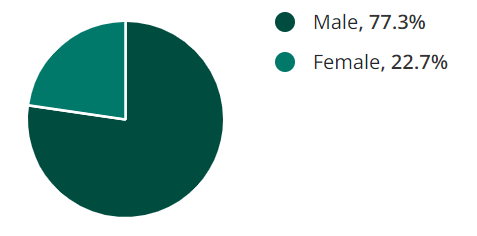
- 58.9 percent of white individuals in the U.S. work as front-end developers.
- The highest annual salary of front-end developers is USD 118,538 in San Francisco.
- The highest demand for front-end developers in the U.S. is in New York.
- Front-end developers in the U.S. are 52 percent more likely to work in public companies than the private ones.
Age Breakdown of Front-End Developers
On average, the age of the front-end developers is between 20 and 30 years. Delve into the common age groups of the developers!

- Nearly 23 percent of front-end developers fall into the age group of 20 to 30 years.
- 43 percent of developers belong to the age group of 30 to 40 years.
- 34 percent of front-end developers are more than 40 years.
React Usage Stats
React is indeed a prominent front-end framework that is quite popular among the developers. Delve into the significant stats relating to this framework!
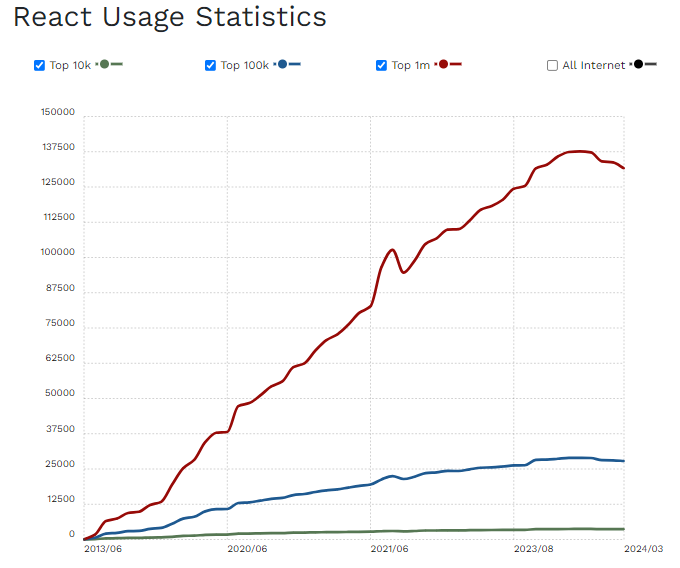
- In the United States, 3,537,618 websites are built using the best React UI framework.
- The use of React JS in the computer electronics and technology sector is 4.06%.
- However, the usage of the framework in the games industry is 2.44%.
- On the other hand, the application of ReactJS in the Science & Education sector is 3.90%.
- CNBC, Canva, and Business Insider India are among the top websites using ReactJS and attracting high traffic.
- 3.4 percent of all websites available on the web make use of the React framework.
- The annual average salary of the React developers in the US is USD 129,846.
Demand for Front-End Frameworks in Different Countries
The demand for front-end frameworks differs from country to country. Delve into the front-end frameworks statistics by country!
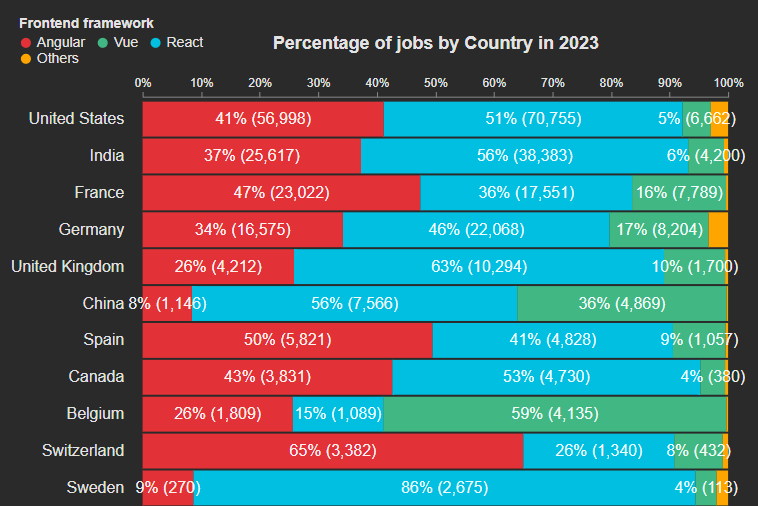
- In the United States, there are 51 percent job opportunities for React while 41 percent for Angular.
- The job offers for React framework in the United Kingdom is 63 percent while that for Angular is 26 percent.
- The demand for Angular jobs is quite high in Switzerland, standing at 65 percent. However, the demand for React is just 26 percent.
- In Sweden, the React job opportunities are 86 percent while that for Angular is 9 percent.
- Belgium offers 59 percent of Vue, 26 percent of Angular, and 15 percent of React job opportunities.
- In Japan, the available React jobs are 63 percent while Vue and React jobs stand at 26 and 10 percent respectively.
- In Finland, the demand for React developers is 73 percent while that for Angular developers is 20 percent.
An Overview of the Highest Paying Front-End Frameworks
It is no surprise that the average salary of front-end frameworks differ. Take a look at some of the highest paying frameworks in the United States.
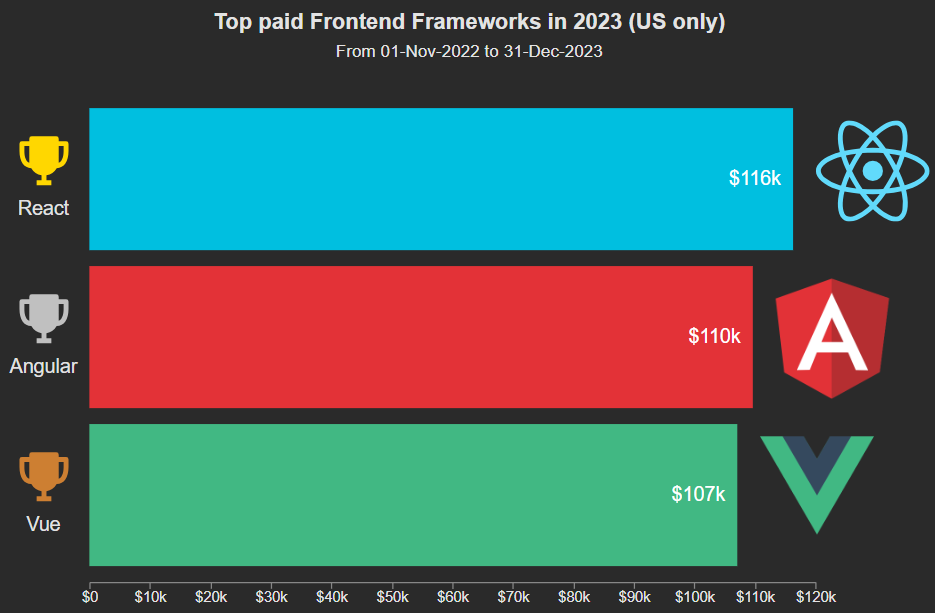
- React is indeed the highest paying front-end framework with an average salary of USD 116k per year.
- The average salary of Angular per annum is nearly USD 110k.
- The average annual salary of Vue framework is USD 107k.
Changing Demand for Front-End Frameworks
In the year 2023, React and Angular were among the most preferred front-end frameworks among developers. While they had a very close market share throughout the year, the distance between both the frameworks slightly increased in the month of December.
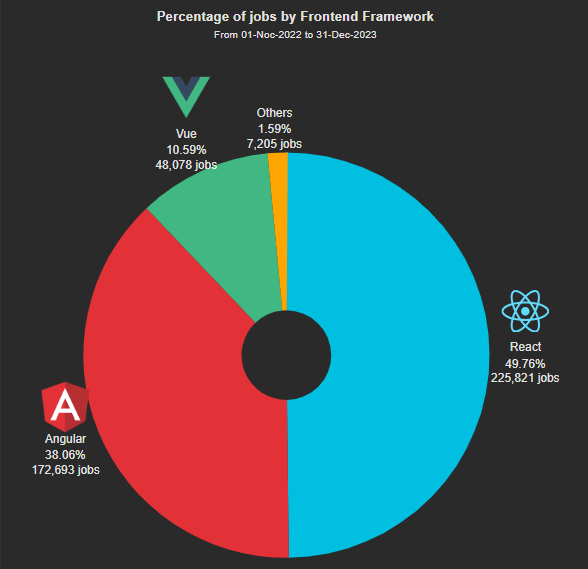
- The number of jobs for the React framework in 2023 was 225,821.
- The job opportunities for the Angular framework were 172,693.
- The demand for Vue developers was 48,078.
Job Titles for Different Front-End Frameworks
When discussing about the front-end frameworks statistics, you must also have an idea about the different job titles available for the popular frameworks. Read on to explore everything in detail!
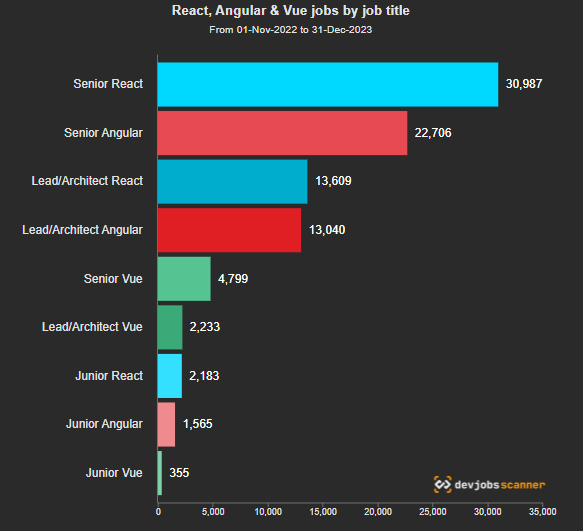
- The number of senior React jobs is 30,987.
- The demand for Senior roles for the React framework is 66.24 percent while the Junior roles stand at just 4.67 percent.
- The need for Lead/ Architect role for the React framework is 29.09 percent.
- The demand for Junior Angular developers is 4.19 percent while that for senior developers is 60.86 percent.
- The need for Lead/ Architect job roles for the Angular framework is 34.95%.
- The senior job offers for the Best VueJS framework stand at 64.97 percent while the junior job offers are 4.81 percent.
Educational Requirements of the Front-End Developers
In order to become a successful front-end developer and stand out in the competitive landscape, possessing the necessary knowledge and skills is crucial. Delve into the prominent educational qualifications of the front-end developers!
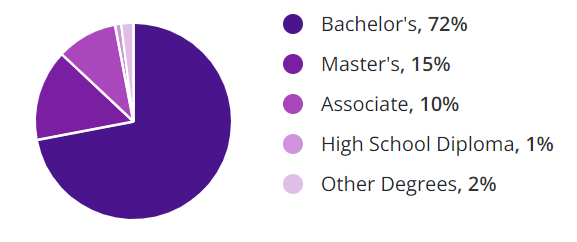
- About 72 percent of front-end developers possess a Bachelor’s degree.
- 15 percent of front-end developers do have a Master’s degree.
- 10 percent of developers have an Associate degree.
- Only 1 percent of front-end developers have completed just a High School Diploma.
Major Subjects of Front-End Developers
No doubt, computer science is the most common major subject for the front-end developers. However, apart from that, there are various other subjects in which the professionals can gain in-depth knowledge. Delve into the major subjects of front-end developers.
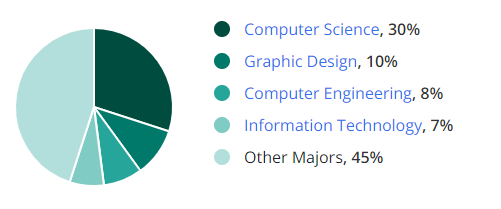
- Nearly 30 percent of front-end developers have a bachelor’s degree in Computer Science.
- 10 percent of developers have a degree in Graphic Design.
- 7 percent of front-end developers have an Information Technology degree.
- 8 percent of front-end developers have completed computer engineering.
Pay Packages of Front-End Developers in the United States
Are you wondering how much the front-end developers in the US make? In that case, delve into the figures below!

- According to Indeed, the average salary of the front-end developers is USD 113,340 per year. However, it can go up to USD 187,403.
- As per Glassdoor, the average pay of the front-end web developers is USD 86,834 per annum.
- According to Built In, the average base salary of the front-end developers in the United States is USD 108,888.
- The top companies recruiting the front-end developers include Amazon, IBM, Google, Verizon, and Insight Global.
Highest Paying Cities in the United States for Front-End Developers
When exploring the front-end frameworks statistics, you cannot leave behind the best paying cities in the US. Delve into the average pay packages in different cities!
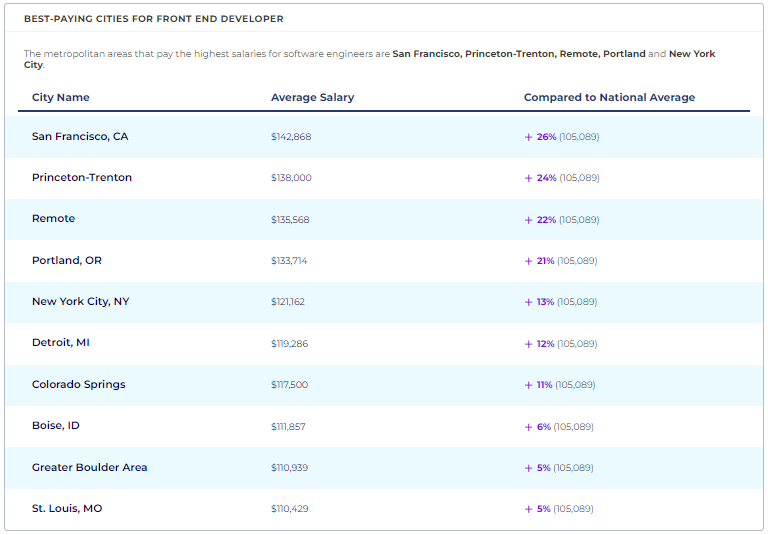
- In the New York City, the average salary of the front-end developers is USD 121,162.
- The average pay of front-end developers in San Francisco is USD 142,868, which is 26 percent more than the national average.
- The salary of the front-end professionals in Detroit is USD 119,286.
- The Greater Boulder Area offers an average salary of USD 110,939 to the front-end developers.
- In Portland, the average pay package of the front-end developers is USD 133,714, which is 21 percent more in comparison to the national average.
- The average annual salary of the front-end developers in Colorado Springs is USD 117,500, which is 11 percent more than the national average.
- St. Louis, MO offers a salary of USD 110,429 per annum to the front-end developers.
Salary of Front-End Developers by Experience
The years of experience play a crucial role in determining the pay packages of the front-end developers. While the freshers can expect a good salary, the pay keeps increasing with more years of experience. Delve into the key front-end frameworks statistics relating to the salaries by experience!
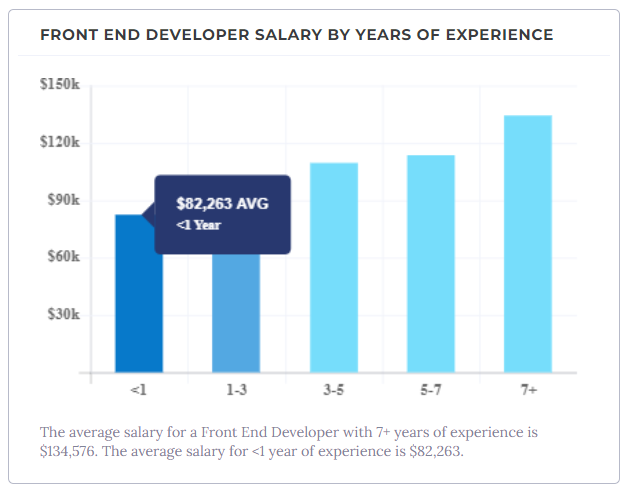
- The average salary of the front-end developers with less than one year of experience is USD 82,263.
- On the other hand, the yearly pay package for front-end developers with more than 7 years of experience is USD 134,576.
- For front-end developers having 1 to 3 years of experience in the industry, the average pay package is USD 93,438.
- The front-end developers who possess 3 to 5 years of experience can expect a pay of USD 109,617.
- The developers having 5 to 7 years of experience in front-end development can get an average annual salary of USD 113,546.
Salary of Front-End Developers Based on Salary
Besides years of experience, the industry where the front-end developers work has also to do a lot with their pay packages. Delve into the salary of the developers based on different industries!
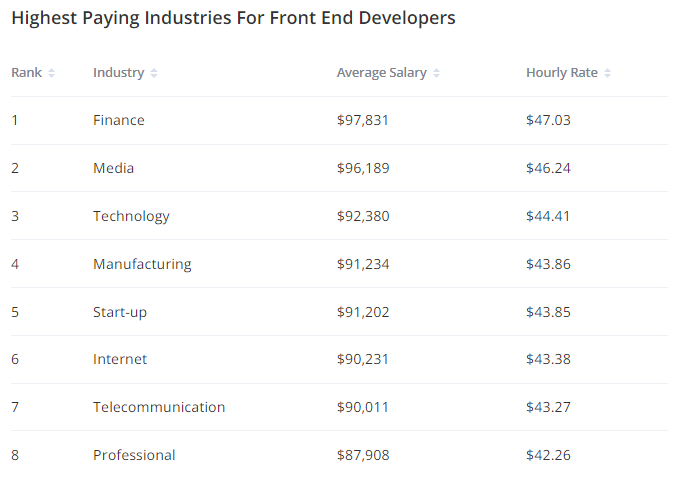
- In the finance sector, the average salary of the front-end developers is USD 97,831.
- The average pay package for front-end developers in the technology sector is USD 92,380.
- The developers working in the start-ups can expect an average annual salary of USD 91,202.
- The average salary of the front-end developers in the media sector is USD 96,189.
Key Statistics of Developer Tools
For effective front-end development and successful outcomes, the use of the right tools matter a lot. While there are several tools available for the developers, delve into the most prominent ones and their usage.

- According to a survey conducted by StackOverflow, Visual Studio Code is used by nearly 74.48 percent of professional developers.
- 32.33 percent of developers prefer using the Visual Studio tool.
- Android Studio is the favorite choice of 19.07 percent of professional developers.
- 16.14 percent of developers show a preference for using the Sublime Text tool.
- 8.85 percent of professional developers make use of the Nano tool.
- About 3.67 percent of developers choose to use GoLand over other tools available.
Company Size of the Front-End Developers
Front-end developers can easily fit into different company sizes. Take a look at the prominent employer sizes in which the proficient developers work.
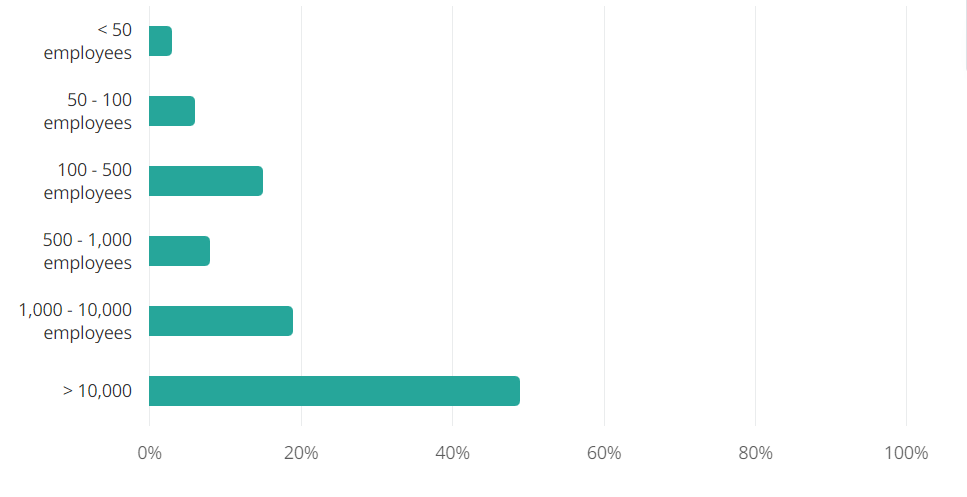
- About 3 percent of front-end developers work in companies with less than 50 employees.
- Companies having 50 to 100 employees hire 6 percent of front-end developers.
- 15 percent of developers are a part of the organizations with 100 to 500 employees.
- 8 percent of front-end developers work in companies having 500 to 1,000 employees.
- Companies with 1000 to 10,000 employees hire nearly 19 percent of front-end developers.
- 49 percent of developers work in organizations having more than 10,000 employees.
Average Tenure of Front-End Developers
On average, the front-end developers remain in their jobs for about 1 to 2 years. Delve into the prominent front-end frameworks statistics relating to the average tenure.
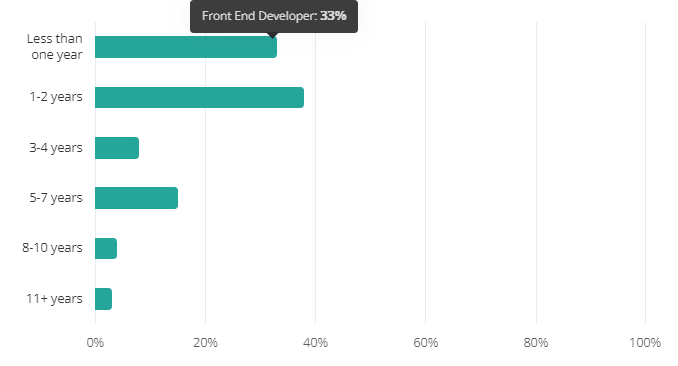
- 33 percent of front-end developers stay at their jobs for less than one year.
- 38 percent of developers stick to their job for 1 to 2 years.
- 8 percent of front-end developers continue their jobs for 3 to 4 years.
- 15 percent of developers are actually stable and remain in their jobs for 5 to 7 years.
- 3 percent of front-end developers stay in their jobs for a tenure of more than 11 years.
Comparison of Salary Difference of Front-End Developers Based on Degree Level
It is no surprise that the front-end developers having a Master’s degree have a greater earning potential than the developers without such degrees. Delve into the earning capacity of different developers on the basis of their degree level.
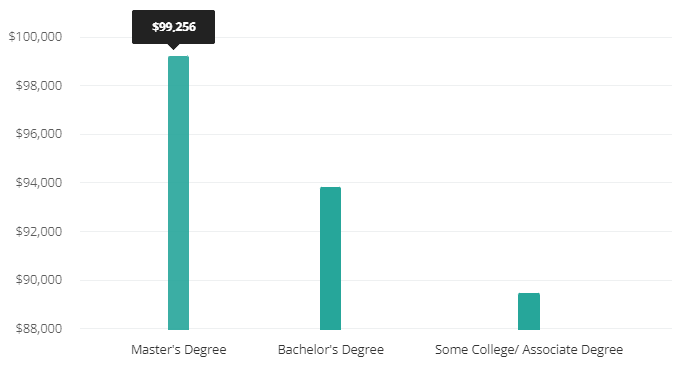
- The median annual income of the front-end developers having a master’s degree is USD 99,256.
- The annual salary of the front-end developers with a Bachelor’s degree is USD 93,883.
- The developers having an Associate degree are capable of earning USD 89,495 per annum.
Exploring the Top Trends of Front-End Development
Front-end development keeps evolving over the years. Delve into the most prominent trends to watch out for in 2024!
Low or No Code Development
The front-end developers are more likely to rely on the low-code or no-code platforms and frameworks. The core aim of low code no code development is to minimize computer programming as much as possible and significantly reduce human errors. This trend will eliminate complex coding and make it easier for developers to focus on business logic. Moreover, it can also ensure rapid customization and development of web apps.
Progressive Web Applications
Progressive Web Application Development is becoming more and more popular owing to the emergence of contemporary technologies like Machine Learning, Voice Support, and Artificial Intelligence. Deployment of these technologies can enable the web apps to offer better engagement to the customers and ensure better retention. The AI and ML technologies can understand the customer behaviors and allow you to build strategies to deliver custom content and recommendations. As a result, retaining app visitors becomes simple and easy.
Micro-interactions and Motion Design
User experience is undoubtedly at the core of any web application. The addition of subtle motion design can help effectively enhance micro interaction and deliver seamless experiences to the visitors. Moreover, the accessibility standards are likely to be customized and refined in order to meet the unique requirements of the customers.
Static Site Generators
Static Site Generators or SSGs are gaining more and more popularity as they are fast, simple, and secure. Moreover, they also offer greater flexibility for the generation of static HTML files. Also, the SSGs can offer faster page loading times, thereby contributing to more responsive web applications.
Voice User Interface
Today, consumers show a growing preference for making online searches through voice commands. Therefore, the adoption of the voice user interface is a growing front-end development trend in recent times. The core goal is to enable users to effectively command apps and get the desired results.
Dark Mode
The dark mode is becoming immensely popular as it provides the users with another choice of user interface. It helps improve the readability and clarity of content, enhancing the overall convenience for the users. Moreover, it can also improve the standards of accessibility and user interface.
Also Read: Amazing Tips & Tricks to Improve React Accessibility
Benefits of Front-End Development
Are you still wondering whether front-end development is worth it? Delve into the most prominent benefits!
Enhanced Performance
Modern front-end frameworks and technologies come with powerful features. So, you can be rest assured about enhancing performance and be able to deliver optimum value to your customers.
Faster Turnaround Time
In this cut-throat competitive era, launching your websites faster is the key to staying ahead. Front-end development allows developers to build the user interface in much less time. As a result, you can take your website faster and gain a competitive edge online.
Easy to Learn
The latest technologies used in front-end development are simple and easy to master. With a small learning curve, developers can easily get hold of the front-end technologies and frameworks and create websites and web apps easily.
Rapid Response
In the fast-paced era of today, visitors do not like to wait. If you have a sluggish website, your abandonment rate is likely to be higher. The latest front-end technologies and frameworks enable developers to build fast responding features, thereby ensuring faster loading websites.
Highly Secure
Coding is completely secure in front-end development. So, you do not have to worry about any issue in the functioning of the site on any existing browser.
Roles and Responsibilities of Front-End Developers
Simply put, hire front-end developers who play a pivotal role in the development of user interfaces of web applications and ensure delivering a seamless user experience. However, in reality, they have various roles and responsibilities. Read on to explore their prominent responsibilities.
User Interface Design
It goes without saying that the front-end developers are involved in designing the user interfaces. They work in association with the UI/ UX designers and translate the wireframes and design mockups into highly functional web pages. Moreover, they are also responsible for ensuring the effective implementation of the different visual design elements.
Responsive Design
Today, designing responsive websites has become more crucial than ever before. It is indeed the secret to attracting more web traffic and retaining your potential customers. The front-end developers help in coding and designing websites and web pages that are highly responsive.
Accessibility
The front-end developers take the charge of ensuring that the web content is readily accessible to all users. It not only enhances the satisfaction level of the users but also allows web applications to adhere to different accessibility standards like WCAG.
Cross-Browser Compatibility
Different users make use of different browsers to access the websites. Therefore, it is essential to ensure that the web pages you develop function well across all browsers. The front-end developers test the web applications and make sure that they work optimally and consistently across different web devices and browsers.
Performance Optimization
If a website doesn’t perform well, the users are likely to abandon the site and switch to the competitors. That is why the front-end developers focus on optimizing the performance. They leverage techniques like lazy loading and minification to optimize web pages for efficiency and speed, thereby minimizing loading times and delivering a smooth user experience.
Web Performance Monitoring
The job of the front-end developers doesn’t end with optimizing the performance of web applications. Instead, they continuously monitor it to determine potential issues, fix them on time, and enhance user experiences. They may make use of tools like WebPageTest and Google Lighthouse for effectively monitoring and improving the performance of the web pages.
Testing and Quality Assurance
The front-end professionals perform various quality checks and conduct tests with the core aim of evaluating the usability and functionality of the web pages. The QA Engineers focus on identifying and resolving potential issues at the earliest time possible.
Front-End Libraries and Frameworks
Professional developers make use of different front-end libraries and frameworks like Angular, React or Vue.JS to streamline the development process. Moreover, they also prioritize enhancing the interactivity of the users.
Troubleshooting and Debugging
The front-end developers take the responsibility of identifying and resolving potential issues like layout problems, broken links, and JavaScript errors. The core aim is to launch flawless applications in the target market and enhance the overall user experience.
Version Control
The developers have expertise in version control systems like Git. It plays a crucial role in allowing front-end developers to collaborate with other developers, track changes, and maintain codebase integrity.
Documentation
The front-end developers also have the charge of keeping proper documentation of the codes and development processes. It helps in effectively troubleshooting and maintaining web applications.
Conclusion
Front-end development continues to evolve over the years at a rapid pace. Therefore, being well aware of the frontend statistics can enable you to make informed decisions for your organization. By now, you must have a complete idea about the key frontend statistics.
From the demand for different frameworks to the annual salary of the front-end developers, you must have gained insights into everything. It is time to partner with the dedicated development team and embark on a journey of success. With the proficient developers by your side, building flawless apps and delivering exceptional user experiences becomes easy.








